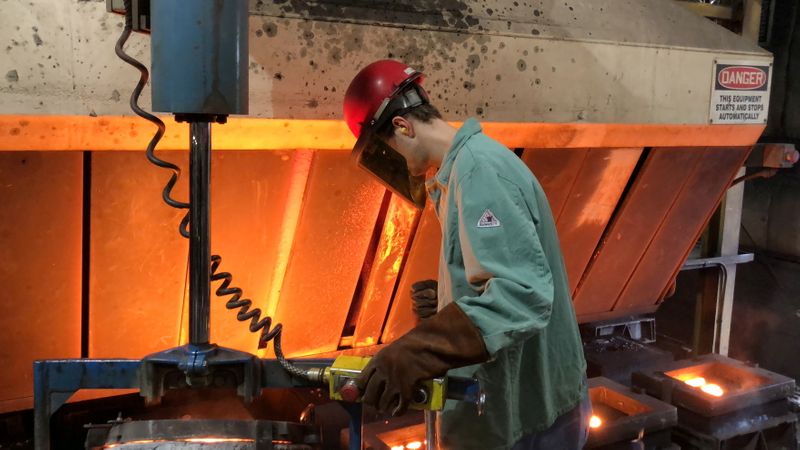
© Reuters. FILE PHOTO: A employee pours scorching metallic on the Kirsh Foundry in Beaver Dam
By Lucia Mutikani
WASHINGTON (Reuters) – U.S. manufacturing exercise grew at a slower tempo in April, restrained by shortages of inputs as rising vaccinations towards COVID-19 and large fiscal stimulus unleashed pent-up demand.
The survey from the Institute for Provide Administration (ISM) on Monday confirmed record-long lead instances, wide-scale shortages of important fundamental supplies, rising commodities costs and difficulties in transporting merchandise throughout industries.
The pandemic, now in its second yr, has severely disrupted provide chains. The ISM famous that “firms and suppliers proceed to wrestle to satisfy rising charges of demand because of coronavirus impacts limiting availability of components and supplies.” It cautioned that employee absenteeism, short-term shutdowns because of half shortages and difficulties in filling open positions may restrict manufacturing’s development potential.
“Manufacturing is struggling to maintain up with roaring demand,” mentioned Will Compernolle, a senior economist at FHN Monetary in New York.
The ISM’s index of nationwide manufacturing unit exercise fell to a studying of 60.7 final month after surging to 64.7 in March, which was the best degree since December 1983. A studying above 50 signifies enlargement in manufacturing, which accounts for 11.9% of the U.S. financial system. Economists polled by Reuters had forecast the index edging as much as 65 in April.
The White Home’s large $1.9 trillion pandemic aid bundle and the enlargement of the COVID-19 vaccination program to all grownup Individuals have led to a increase in demand, which is pushing towards provide constraints. Federal Reserve Chair Jerome Powell mentioned final week the U.S. central financial institution anticipated the bottlenecks could be resolved as staff and companies tailored and “we consider them as not calling for a change in financial coverage.”
Inventories at factories and clients are extraordinarily lean, which ought to maintain manufacturing buzzing.
“There’s little purpose to suppose circumstances are softening,” mentioned Joel Naroff, chief economist at Naroff Economics in Holland, Pennsylvania.
U.S. shares rose as upbeat earnings strengthened hopes for sustained revenue development for firms. The greenback fell towards a basket of currencies. U.S. Treasury costs have been increased.
(Graphic: ISM PMI: https://graphics.reuters.com/USA-STOCKS/jbyprwznwve/ism.png)
“CRAZY HIGH” STEEL PRICES
All 18 manufacturing industries continued to broaden in April, with furnishings producers reporting that “market capability in most areas is oversold” and anticipated that “demand will proceed to strengthen, resulting in extra important disruptions.” Within the plastics and rubber merchandise sector lead instances have been the longest in 35 years for some factories.
Producers additionally complained about metal costs, which makers of fabricated metallic merchandise described as “loopy excessive.” Imported metal costs have been boosted by tariffs imposed by former President Donald Trump to guard home industries from what he mentioned was unfair competitors.
Electrical tools, home equipment and parts producers reported “it is getting rather more tough to provide manufacturing with supplies which might be made with or metal,” noting “a number of work on the ground.”
Within the vehicle business, a world semiconductor chip scarcity has compelled cuts in manufacturing. Ford Motor (NYSE:) Co mentioned final week the shortage of chips slashed manufacturing in half in its second quarter. Expertise firms are additionally feeling the warmth. Apple (NASDAQ:) warned final week that the chip scarcity may dent iPads and Mac gross sales by a number of billion {dollars}.
Demand for items like motor automobiles and electronics has surged in the course of the pandemic as Individuals shunned public transportation and tens of millions labored from residence and took lessons remotely. Sturdy client spending helped to elevate gross home product development at a 6.4% annualized price within the first quarter.
Most economists count on double-digit GDP development this quarter, which might place the financial system to realize development of at the least 7%, which might be the quickest since 1984. The financial system contracted 3.5% in 2020, its worst efficiency in 74 years.
The ISM survey’s measure of costs paid by producers rose final month to the best studying since July 2008, when the financial system was within the midst of the Nice Recession. That bolsters expectations for increased inflation this yr.
“But not like in 2008, demand is way from wavering,” mentioned Tim Quinlan, a senior economist at Wells Fargo (NYSE:) in Charlotte, North Carolina. “That has put producers in a greater place to cross on prices than see their margins squeezed.”
The survey’s forward-looking new orders sub-index dropped to 64.3 after racing to 68.0 in March, which was the best studying since January 2004.
Backlogs of uncompleted work elevated as did export orders. Producers began drawing down on inventories final month to satisfy demand. Enterprise warehouses are virtually naked.
The survey’s manufacturing employment gauge fell to 55.1 after taking pictures as much as 59.6 in March, which was the best studying since February 2018. The index was properly beneath the 61.5 forecast within the Reuters ballot, with the slowdown in hiring most likely because of a shortage of staff.
Firms throughout many industries are struggling to search out staff, at the same time as employment is 8.4 million jobs beneath its peak in February 2020. The employee scarcity may damage expectations for one more month of blockbuster job development in April.
In accordance with an early Reuters survey of economists, nonfarm payrolls possible elevated by 980,000 jobs final month after rising by 916,000 in March. The federal government is because of publish April’s employment report on Friday.
A separate report on Monday from the Commerce Division confirmed building spending gained 0.2% in March after falling 0.6% in February.
Graphic: Development spending: https://graphics.reuters.com/USA-STOCKS/azgvoxqlepd/constspend.png







